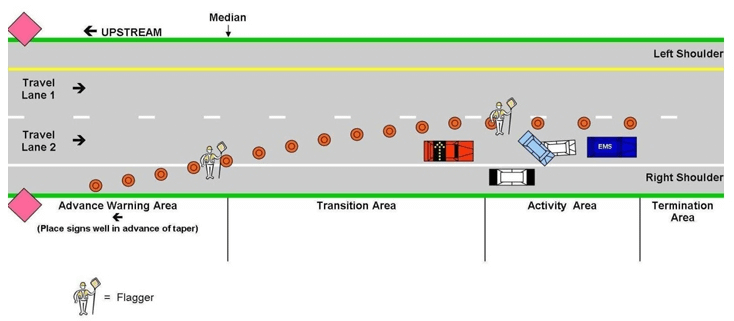Traffic Cone Placement
FHWA Guidelines for Traffic Cone Placement: According to FHWA, traffic cones should be placed in a specific manner to ensure optimal safety on roads. First, always face traffic when placing cones, so drivers can see them from a distance and adjust their speed accordingly. Place the cones at regular intervals, with a minimum spacing of 30 feet in between, to create a clear path for drivers to follow. Use additional cones to indicate any hazards or obstacles, such as lane closures or debris, and to guide drivers to the correct lane.

In construction zones, FHWA recommends using heavier cones with reflective tape for better visibility, and placing them at a distance of at least 200 feet from the work area to provide ample warning to drivers. In accidents or emergencies, use cones to block off the affected area and divert traffic away. Finally, always remove cones as soon as possible to prevent any confusion or accidents.
Traffic cones are an essential part of road safety, used to signal hazards and guide traffic through construction zones, accident scenes, and other temporary obstacles. Proper traffic cone placement is crucial to ensure the safety of drivers, pedestrians, and workers alike. In this article, we'll cover the best practices for placing traffic cones in various scenarios, from urban streets to highways.
Construction Zones: When working on a construction site, traffic cones play a vital role in keeping workers and drivers safe. First, determine the appropriate size and weight of the cones needed for the job. Then, place the cones at regular intervals to create a clear path for drivers to follow. If there are any hazards, such as uneven pavement or debris, use additional cones to warn drivers to slow down or change lanes. Finally, make sure the cones are placed far enough away from the work area to prevent any accidents.
Accidents and Emergencies: When a car accident occurs, traffic cones can help to prevent further damage and keep drivers safe. Place cones around the accident scene to block off the area and divert traffic away from the crash. Use cones to create a clear path for emergency vehicles to enter and exit the scene. Finally, be sure to remove the cones as soon as possible once the accident has been cleared.
Highways and Freeways: On highways and freeways, traffic cones are often used to redirect traffic during lane closures or construction. When placing cones on these roads, make sure they are visible from a distance and placed at regular intervals to guide drivers. Use additional cones to indicate lane closures or changes in the road's direction. Finally, be sure to remove the cones once the work is complete or the accident has been cleared.
Conclusion: Traffic cone placement is a crucial aspect of road safety, and following these best practices can help to prevent accidents and keep everyone on the road safe. Whether you're working on a construction site or responding to an accident, knowing how to place traffic cones correctly is essential. By following these tips and tricks, you'll be able to master traffic cone placement and ensure the safety of drivers and pedestrians alike.
Following FHWA's recommended best practices for traffic cone placement can ensure the safety of drivers, pedestrians, and workers on the road. Proper placement of traffic cones can prevent accidents, redirect traffic, and provide a clear path for drivers to follow. Whether you're working on a construction site or responding to an accident, it is essential to know how to place traffic cones correctly. By following these FHWA guidelines, you'll be able to master traffic cone placement and create safer roads for everyone.